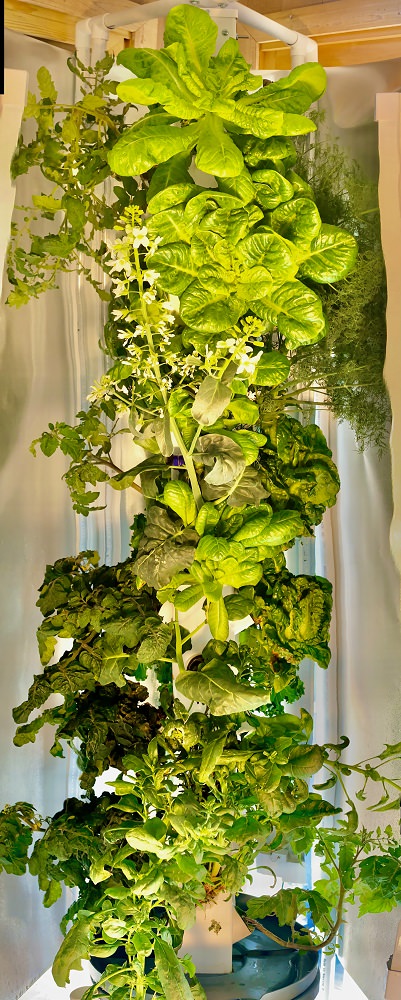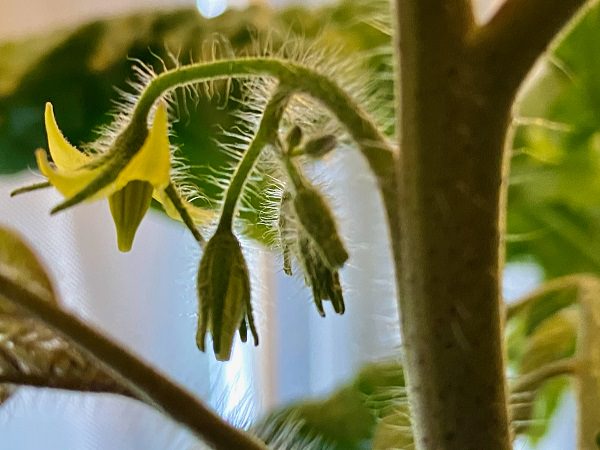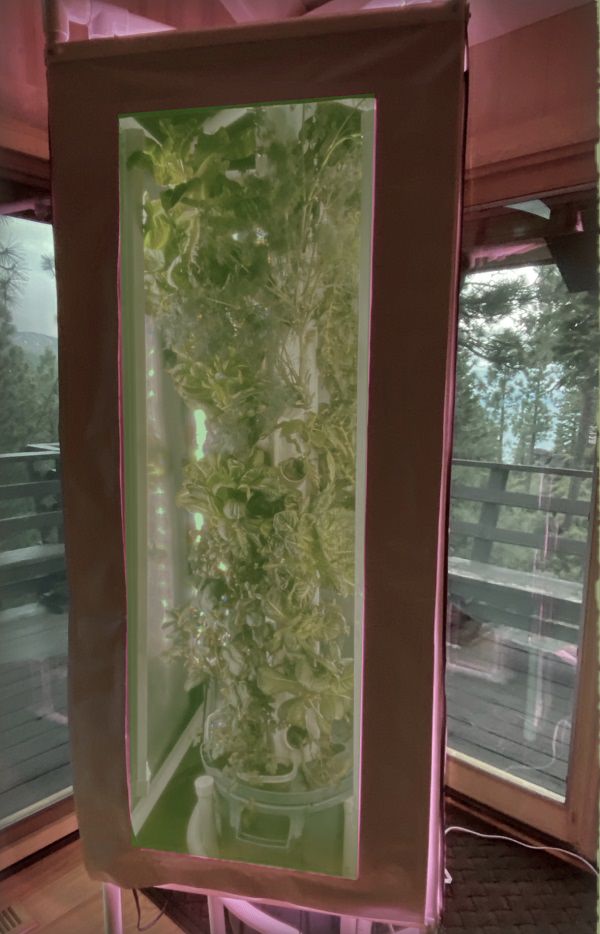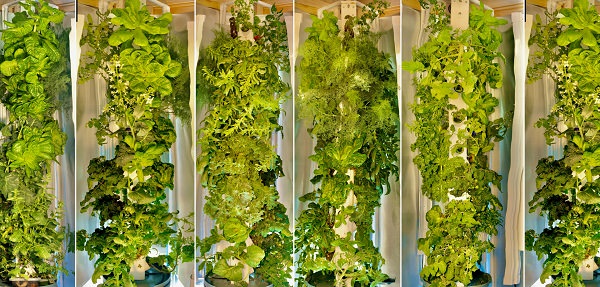There is something indescribably delicious about the vibrant taste of freshly picked vegetables. This year we witnessed a renewed and robust interest in growing healthy food at home. An unprecedented number of people started or expanded their home gardens, with a spring/summer rush on garden supplies. Many discovered the joys and benefits of home gardening, enjoying freshly picked veggies bursting with flavor and nutrition and free from pesticides and pathogens. The challenges that often come with outdoor gardening — the time investment and hard work, the dirty process, critters and pests that often attack plants, unpredictable weather, and a short growing season — have caused many people to seek better and easier methods for growing their own food.
Now there is a better way down the garden path: indoor gardening! While this may bring to mind a small herb garden in the windowsill or a row of stacking grow shelves with lights, 2020 has illuminated the way forward with new technology set to transform how we grow and consume food.
I
The Column Farm is an indoor vertical growing system that allows you to grow food indoors year round
High-Performance Indoor Gardening
Introducing the Column Farm, a high-performance indoor garden (patent pending) designed and built locally by Tahoe Gardens, Inc. The Column Farm is a vertical grow system that allows you to cultivate 32 full-sized plants (herbs, greens, tomatoes, peppers, strawberries, flowers, medicinals, etc.) in a small 30-inch footprint.

The Column Farm allows you to grow a lot of plants in a very small, 30-inch footprint
With an automatic, aeroponic water- and nutrient-delivery system, there is no dirt, no mess, and less effort required. It also uses 98 percent less water than outdoor growing methods. With an ultra-efficient LED grow lighting system, no sun is required, so you can grow food reliably year round. Imagine fresh tomatoes and strawberries in January!


While there are several other products that attempt to improve indoor gardening, only the Column Farm delivers the high productivity, efficiency, and wide range of plant options most people desire — think flowering plants such as tomatoes, peppers, strawberries, etc. The reason is simple: The Column Farm lighting system delivers an abundance of light that makes plants not only thrive, but flourish in great abundance. Besides powerful LED grow lights tuned to the spectrum plants love, the Column Farm employs reflective curtains that reflect light repeatedly back onto the plants. Most light is utilized by the plants, not lost into the room or environment. By containing most of the light inside the system, the Column Farm is able to maximize lighting power while minimizing glare into living spaces. The results are a wider variety of plant types and higher yield. No other system operates at this level of performance and productivity as safely and comfortably.

LED grow light is reflected onto plants thanks to reflective curtains
Space-Age Aeroponics Used by NASA
Aeroponics is an advanced embodiment of hydroponics. Aeroponics is a plant-cultivation system in which the roots are suspended in air and sprayed or misted with a nutrient solution. Used by NASA since the 1960s and employed on the International Space Station, this technique provides for maximum nutrient absorption, which research has shown translates into a faster growth rate (up to three times faster) and higher yields (up to 30 percent). It also uses up to 98 percent less water than traditional growing methods.
The Column Farm utilizes aeroponics in a vertical grow system. Water and nutrients are pumped from a storage reservoir up the center of the column periodically every 15 to 20 minutes and cascade down over the roots to deliver the perfect complements of nutrients, water, and oxygen. The roots (which reside inside the column) are supported in a porous grow medium (such as coco coir or rock wool) contained in plant baskets that line the four sides of the column.
Perpetual Plant-Growing Machine, From Seed to Harvest
A unique and impressive feature of the Column Farm is the built-in seed-to-harvest process. Integrating an onboard Germination Station affords the ability to grow seedlings in parallel with mature plants. This allows you to transfer newly germinated seedlings to the column as you harvest mature plants, essentially creating a perpetual plant-growing machine!
Seedlings typically take between two and four weeks in the Germination Station; then they are ready to transplant to the column. Time to maturity from there is about four to eight weeks, depending on plant variety. This allows you to produce a satisfying six to 12 harvests per year. An added bonus is that any excess seedlings grown and not transferred to the column may be enjoyed as microgreens!
Expandable from Standalone to Large-Scale Warehouse Arrays
Another benefit of the Column Farm is its scalability. The modular design creates the flexibility to tightly pack Column Farms side by side along a wall, fill a grow room or garage, and even expand to large arrays in a warehouse environment. Not only can you use the Column Farm to provide fresh food for yourself and your family, you also can grow produce for a neighborhood, community, or city by expanding your system — all grown locally, pesticide free, and close to where it is consumed.
Growing Food More Easily and Conveniently Indoors
While there are several considerations for setting up and maintaining an indoor grow system, the Column Farm makes most of these easier and more convenient.
The Column Farm takes advantage of efficient vertical volume space, thus greatly reducing grow space footprint. The compact size of 30 inches wide by 30 inches deep with a height of 80 inches allows the Column Farm to be placed in a medium closet, pantry, room, basement, garage, shed, or other suitable indoor space.
The unique rotating center plant column allows easy access to plants from any side without having to move the unit, a great benefit in tight spaces or corners. The modular dimensions and rotating column also allow groups of Column Farms to be configured in dense arrays to efficiently fill very large spaces. Units are easily movable on castors for relocation or to create access between rows in densely packed environments.
Plants thrive in the same environment humans find comfy. Temperature ranges of 65 to 75 degrees Fahrenheit are ideal, and 45 to 85 degrees is tolerable; and a relative humidity range of 30 to 70 percent is ideal while 10 to 90 percent is tolerable. This makes controlled environments inside the home ideal for growing plants. Additional consideration should be taken for locations that are not environmentally controlled, such as a garage or shed.
Electricity is needed to power the automatic lighting and watering system. With an efficient LED system and less than 250 watts of power consumption (drawing 2 amps at 120 volts), a standard 120-volt, 15-amp outlet can support several Column Farms. Solar and battery systems may also be used to power the system for off-grid growing.
The Column Farm contains a water and nutrient reservoir and provides automatic watering and nutrient delivery. You only need to add two to four gallons of water per week (depending on plant size) and maintain nutrient chemistry by adjusting levels using the supplied premixed nutrient solution and a test device to measure pH and TDS (Total Dissolved Solids).
Another advantage of growing indoors is greatly reduced risk of pest infestation. Occasionally bugs can find their way indoors (through an open window or door, or via a plant brought in from the outside). There are several effective organic methods to deal with this rare problem should it occur, including using a diluted Neem Oil spray solution mixed with soapy water.
Tending to the Column Farm should average about 30 minutes per week. This includes trimming plants, adding water, and maintaining nutrient balance. Tending to the Germination Station takes about five minutes per day.
As with all hydroponic and aeroponic systems, periodic system cleaning is required. We recommend cleaning the Column Farm every three months to keep the system operating at maximum efficiency and productivity. Cleaning time is about one hour every three months.
Personal Satisfaction
Few presently know how to grow food indoors, let alone in a highly productive fashion. Using the best tools available, learning how is not difficult, and the rewards are well worth the effort. Growing plants should be an enjoyable process for you and your family. Eating healthy food you grow is a very satisfying result. And knowing that the food you grow from seed to harvest is not only highly nutritious, vibrant, and delicious, but also pesticide and pathogen free is priceless.
Start growing your own healthy food indoors this winter with the Column Farm. Learn how at TahoeGardens.com.


